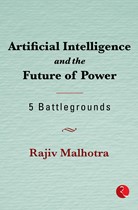
“It is extremely easy to find people who speak pleasantly. But it is rare to find people who speak and hear true words even when they are not pleasing to hear.” Rajiv Malhotra opens this book with this quote from the Ramayana, which, in a few lines, summarises the essence of the whole book. With the USA and China as a benchmark for developments in AI capabilities, Malhotra paints the real picture of India which he considers to be real in the given field and has written about what lies ahead in its road to glory. Substantiated by facts, reasoning, analogies, and witty observations, this book serves as a call to action for public intellectuals to become more active, at the same time, intending to challenge the narrative that is being fed to the Indian diaspora about its trajectory of becoming a technological superpower.
The author begins the ‘journey’ through his book by laying the fundamental concepts in the realms of Artificial Intelligence and machine learning, including explanations on the notions of big data, deep learning, neural networks, and so on. The interaction between humans and machines has changed drastically with the advent of wearables (smartwatches, smart glasses, et cetera), smart homes, digital assistants like Alexa and Siri, which have impacted and influenced the human psyche. Since these machines/softwares operate with high accuracy and efficiency, the world is seeing an acceleration at which jobs, traditionally done by humans, are being replaced by them. The author analyzes the involvement of machines and AI-based technology in healthcare, transportation, military, agriculture, education, financial services, and so on. He lays down questions pertaining to data privacy and biases, which could compromise the equilibrium of human society. Talking about the possible realities of the future, Malhotra is critical of the Indian intellectuals, thinkers, and visionaries and their ignorance of this looming threat to India, saying that “they tend to either escape into science fiction or dismiss concerns about AI as a conspiracy theory.” In the first chapter, the author sets the tone for the whole book and divides his analysis specifically into economics, geopolitics, psychology, and metaphysics. He then gives a detailed analysis of India’s current position in this AI race.
On the economic front, Malhotra extensively uses the term ‘Data Capitalism,’ which considers big data as the new kind of capital asset. He argues about the grave situation in the future concerning jobs and employment. Automation and mechanization of various industrial processes, coupled with the inability of the Indian education system to re-educate its workers for the ‘jobs of the future,’ makes the author believe that India could be possibly recolonized by the future world powers. However, this colonization could happen based on the capabilities in the realms of AI and technology. These phenomena can further exacerbate the buying power of consumers and eventually sabotage the economic growth of the country. The author finally gives his insights on how the pandemic could accelerate these trends and influence the equilibrium of world powers.
Moving forward in the third chapter, the author touches upon how AI is shaping the race of world domination and the developments in the geopolitical arena. He also coined the term ‘digital colonization’ to describe how the technologically developed economies prey on the poorer economies (especially in Latin America and Africa). These countries mine raw data from the poorer countries, which they can possibly use to evolve algorithms and become stronger. The author attributes these events to highly ignorant and corrupt leaders who sell their nation’s data sovereignty for short-term benefits, compromising national security in the long run. He critically analyses China specifically in AI development, analogously comparing its rise to the imperial industrialization that started in 18th century Britain. According to him, China’s entire nation-building plan is based on AI and has made huge investments in the same by utilizing its infrastructure of roads, trains, seaports, and digital highways. According to the author, in the future where AI defines global power, it is the countries like China, who will replace the USA as the next global power.
Next, in the fourth and the fifth chapters, the author talks about how AI technologies are taking over human agency and metaphysics. He is critical of the sneaky behaviour of global tech giants like Facebook, Google, Microsoft, and Amazon when it comes to employing its machine learning technology to map human psychology. These technologies give insights into how customers make choices and help these firms to develop detailed profiles of people, and societies, and communities as a whole. He also discusses how consumers are getting addicted to the instant gratification, aesthetics, and artificial pleasures of these platforms. Throughout the analysis, the author mentions various concepts and theories that clarify how the aestheticization of politics and power is caused by the intrusion of technology in the public space and how big firms strategically use aesthetics to achieve goals in a pragmatic sense. In the domain of metaphysics, since AI’s success is built on teaching machines to behave intelligently, the notion that life, mind, and consciousness are just biological processes carried out by humans as machines has taken form. It essentially suggests that the digital industry is moving in the opposite direction of movements that seek to raise consciousness which eventually boils down to a battle between algorithm and consciousness.
Finally, the author talks about how India is poised in the global race for AI domination. He predicts that India will face difficulties while laying down AI frameworks since it has been dealing with prevailing problems of high population, poor education standards, chronic unemployment, et cetera. He attributes all of it to the weakening of Indian thought and creativity because of a prolonged period of repression and colonization in its recent past. He further analyses how India successfully gave up its lead in IT innovations and is now moving towards being just a market for American technology and Chinese hardware. Recently, there have been incidents in India which, according to the author, are the consequences of sheer ignorance of the Indian intellectuals and visionaries. With the psychological vulnerabilities of India, the author believes that it gives numerous opportunities to various foreign powers to establish new myths and values, altering the Indian grand narrative.
I would definitely urge all Indians, especially the youth, to read this book because this book brings out some startling facts about the future of civilization. With the advent of social media and its intermingling with lives, the uneducated and the youth happen to be the most vulnerable segment of Indian society, as far as AI disruptions in the future are concerned. As mentioned in the book, the author feels that India is at a place where, chasing the western and capitalist glitter, it has come far from its identity, putting itself in a situation where it cannot identify itself in either of the categories. These realities make India a perfect satellite for nations like China and the USA to exploit to support their development. In this paradigm, we need to identify the faultlines, which to some extent, this book does, and seriously take cohesive action to emerge as a leader in AI developments in the future.













